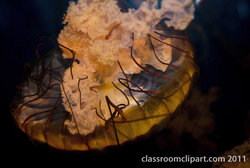Jellyfish
|
|
| Jellyfish | ||||||
|---|---|---|---|---|---|---|
 Little Blue Jellyfish | ||||||
| Scientific classification | ||||||
| ||||||
| Orders | ||||||
|
Stauromedusae |
Jellyfish (also called jellies or sea jellies as they are not true fish) are animals that belong to Phylum Cnidaria, included in the class Scyphozoa (from Greek skyphos "cup" and zoon "animal"). The name "jellyfish" is also sometimes used for the related classes of medusae (Hydrozoa) and box jellyfish (Cubozoa). Almost all jellyfish live in the seas and though they lack true organ structures they feature specialized tissues. The adult forms of these creatures are composed of 95-99% water. All species are found in each of the world's oceans, with a few species living in fresh water. Most jellyfish are passive drifters that feed on small fish and zooplankton that become caught in their tentacles. Jellyfish have an incomplete digestive system, meaning that the same orifice is used for both food intake and waste expulsion. They are Coelenterates which means "hollow gut", and are made up of a layer of epidermis, gastrodermis, and a thin jelly-like layer called mesoglea that separates the epidermis from the gastrodermis.
Jellyfish have two major body forms throughout their life. The first form is called the polyp stage and is characterized by either a non-moving (sessile) stalk that catches food drifting by or a similar form that is free-floating. Their mouth and tentacles are located anteriorly, facing upwards. The second form looks like a saucer is called the medusa stage and is characterized by a round (radially symmetric) dome-shape body plan with food catching tentacles hanging down. It is this form which is most able to respond to and interact with its environment and is also the form most people are familiar with.
With few exceptions, jellies are dioecious, which means that each animal is either male or female. A group of animals releases sperm and eggs which may mix in the water column and become fertilized or, in the case of the moon jelly (Aurelia), the eggs become lodged in pits on the oral arms, which form a temporary brood chamber where fertilization takes place.

After fertilization and initial growth, a larval form, called a planula, develops from the egg. The planula larva is small, and is covered with cilia. You could think of it as looking like a tiny hairy football. The planula larva settles onto a firm surface and changes into a polyp. The polyp resembles a tiny sea anemone— cup-shaped with tentacles surrounding a single opening. Once the polyp begins reproducing asexually by budding, it's called a segmenting polyp, or a scyphistoma. New scyphistomae may be produced by budding or new; immature jellies called ephyra may be formed. These young jellies swim off and grow up into adults.
Like all other cnidarians, jellyfish have stinging cells called cnidocytes, which contains the stinging nematocysts on their tentacles. Whenever a prey comes in contact with a tentacle, hundreds to thousands of nematocysts fire one or another type of "hook and line" into the prey's direction. These stinging cells are thus able to latch onto the prey and the tentacles bring the prey item into their large "mouth" for digestion.These cells are activated by a simple but precise nervous system called a nerve net which is located in the epidermis of the jellyfish. Impulses to these nerve cells are sent from the nerve rings that have collected information from the environment of the jellyfish through the rhopalial lappet, which is located around the animal's body. Jellyfish also have "eyes" or ocelli that cannot form images but are sensitive to light. Jellyfish do not have a specialized digestive system, excretory system, respiratory system, and circulatory system. They can digest with the help of the gastrodermis that lines the gastrovascular cavity, where nutrients from their food is absorbed. They do not need a respiratory system since their skin is thin enough that oxygen can easily diffuse in and out of their bodies. They do not have a brain, a heart, a central nervous system, a skeletal system and also no bones and no blood. Jellyfish move using a hydrostatic skeleton that controls the water pouch in their body to manipulate their movements.
Most jellyfish are not dangerous to humans but a few are highly toxic, such as the Cyanea capillata. Contrary to popular belief, the menacingly infamous Portuguese Man O' War (Physalia) isn't a jellyfish, but a colony of hydrozoan polyps.
Many aquaria, such as Monterey Bay Aquarium, Vancouver Aquarium, and Maui Ocean Center, feature jellyfishes in display. Often the tank's background is blue with the animals illuminated by side lighting to produce a high contrast effect. In natural conditions, many of the jellies are so transparent that they can be almost impossible to see.
A group of jellyfish is often called a 'smack'.
Some types
- Sea nettle
- Moon Jelly (Aurelia aurita)
- Cubozoa (Box Jellyfish or Sea Wasp)
- Cassiopeas
- Cotylorrhiza tuberculata (also called Fried Egg Jellyfish).
- Rhizostoma pulmo (also called Rhizostoma octopus and White Jellyfish).


